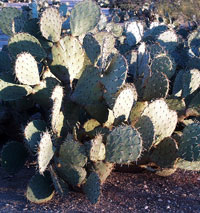|
Cactus (Cactaceae) Cactus exhibit strange shapes, spines, and showy flowers. Today, they are found around the world. All but four varieties are native to the Americas. Like all living things, cactuses vary greatly. Some cactuses look like pincushions. Others resemble starfish or even blades of grass. There are about 2,000 different species of cactuses. Every cactus of a given species does not look exactly alike. For example, spines may vary in length and color. |
|||||||||||||||||
|
Characteristics: Most cactus are stem succulents. They have fleshy stems. Most have very little woody tissue. They never have leaves. Cactus spines probably evolved from leaves. Most cactus cannot remove water from cold soils, so they are dormant in winter and grow in summer. Size: Cactuses vary widely in size and shape. The giant saguaro looks like a bare tree with thick, upturned branches. They can grow as tall as 60 feet (18 meters). Other cactuses are less than 1 inch (2.5 centimeters) high. |
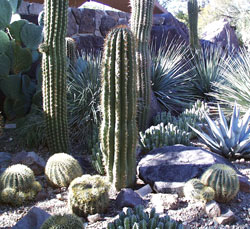 |
||||||||||||||||
|
Desert
Garden
|
|||||||||||||||||
|
Where Do They Grow? Most cactus species grow in hot, dry regions. They are common in Mexico and the Southwestern United States. They can also be found on mountains, in rain forests, and the polar regions. |
|||||||||||||||||
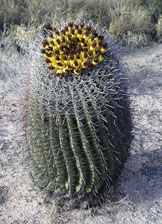
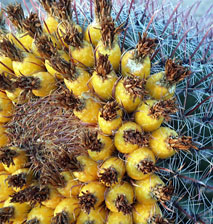 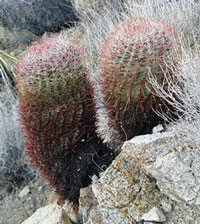 |
|||||||||||||||||
|
Arizona
Barrel Cactus
|
Barrel
Cactus Fruit
|
California
Barrel Cactus
|
|||||||||||||||
| Parts of a Cactus: The structure of cactuses help them to survive in hot, dry climates. Most have thick, fleshy stems with waxy skin. The stem stores water. The tough skin keeps the water from evaporating. | |||||||||||||||||
|
|
Cactus spines keep the plant from being eaten by most animals. Cactus spines can be short, long, soft or sharp. Spines can be straight or hooked. Spines grow on the stem in clusters called areoles. The areoles sometimes form patterns along the cactus. Look for the ridges in the barrel cactus above. The ribs give the plant shade and help store water. There are two types of spines. Centrals are heavier, colored, and often hooked. Radials are usually straight and scattered around. |
||||||||||||||||
| Engelmann's Prickly Pear | |||||||||||||||||
|
Some cactuses are fluted or ribbed. Some have shapes called tubercles. In tubercles, the areoles are at the tips. All cactuses produce flowers. They can usually be seen on the areoles. Flowers can be white or a bright color such as yellow, orange, red, or lavender. For most cactuses, flowers only bloom for a few days. Some flowers open only at night. |
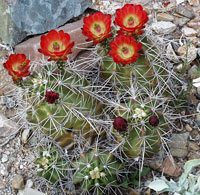 |
||||||||||||||||
|
Claret
Cup Hedgehog
|
|||||||||||||||||
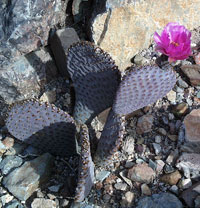 |
Cactuses have extremely long roots to reach out through the sandy, rocky soil. These roots grow close to the surface collecting water. A large saguaro may have root systems that are 50 feet (15 meters) long. After a heavy rain, these roots soak up and move large amounts of water to the plant stem. |
||||||||||||||||
| Beavertail Prickly Pear | |||||||||||||||||
|
Life Cycle: All cactuses reproduce. Their flowers have both male and female parts. The male part yields pollen. The female part contains an egg. Birds, bats, and insects are attracted to the colors or the scent of the flowers. While feeding, these creatures transfer pollen from one part to other parts of the plant. This process is pollination. This causes a fruit to develop. This cactus fruit is a fleshy berry that contains seeds. Seeds are scattered by birds, wind, and rain. A cactus plant may produce about million seeds. Only one or two seeds will live to become a new cactus. |
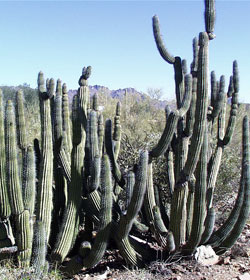 |
||||||||||||||||
|
Organ
Pipe
|
|||||||||||||||||
|
Some cactuses reproduce without seeds and flowers. Both prickly pear and cholla cactuses have stems with weak joints. When a stem breaks off, it sometimes grows in the soil and becomes a new plant. Most cactuses grow very slowly. It could take a year to grow 1 inch (2.5 centimeters). Older plants may grow 3 or 4 inches (7.5 to 10 centimeters) each year. They can live 50 to 200 years. Kinds of Cactuses: Some of the most common cactuses found in the Southwestern United States include the barrel, prickly pear, organ pipe, cholla, barrel, and saguaro cactuses. |
|||||||||||||||||
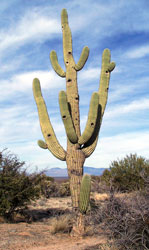 |
Saguaro, organ pipe, and barrel cactuses are members of the same family. The saguaro, pronounced se-WAR-oh, may have as many as a dozen armlike branches. The main stem can reach 40 to 60 feet (18 meters) high and 2 feet (0.6 meter) in diameter. Saguaro provide homes for many birds such as Gila woodpeckers, gilded flickers, elf and screech owls, purple martins, and house finches. A fifty foot saguaro (Left photo) weighs as much as nine tons. It can live for as long as 200 years. The organ pipe cactus (Shown above right) has tall stems that grow in groups. They look like the pipes from an organ. They have slender arms. Branching is a way to increase their surface area and food production. They are found only in places like southwestern corner of Arizona and northern Mexico. |
||||||||||||||||
| Saguaro | |||||||||||||||||
| The barrel cactus looks like a barrel. It is one of the most common kinds of cactuses. They can grow up to 10 feet (3 meters) tall. They can also be tiny. All barrel cactus have ribs and tough spines. Barrel fruits always form at the top of the plant. The fruits are fleshy and juicy, but aren't good to eat. | |||||||||||||||||
|
Chollas and prickly pears are members of the same family. Stems of the jumping cholla, or chainfruit cholla, fall off easily. Some people say they 'jump' on people as they walk by. Teddy bear cholla have light brown, sharp spines that pierce tender skin. They are hard to get out. From a distance, they look soft like a teddy bear. These chollas grow to about 5 feet (1.5 meters) tall. Desert packrats create their dens with cholla joints and other things such as sticks and prickly pear pads. They build tiny tunnels to protect themselves from foxes, coyotes, and other predators. Some of these nests are hundreds of years old. They are dirty and unhealthy, so don't touch them. |
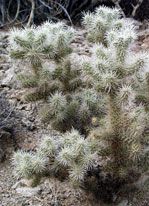 |
||||||||||||||||
|
Teddy
Bear Cholla
|
|||||||||||||||||
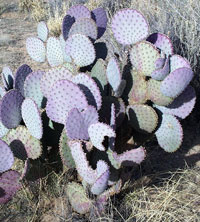 |
Prickly pears are many-branched. Prickly pear branches, often called pads, are flattened and look like overgrown, fleshy leaves. They have large spines as well as clusters of easily detached tiny spines called glochids. These glochids are barbed, very small, and hard to remove when stuck into skin. The fruits of prickly pear are juicy and edible. They must be carefully peeled before eaten. Some people also gather, cook, and eat the pads of prickly pear as a vegetable. Some animals such as javelinas love to eat prickly pear cactus. You can sometimes see the bite marks on the cactus. |
||||||||||||||||
|
Santa
Rita Prickly Pear
|
|||||||||||||||||
|
Value of Cactuses: Cactuses are important to animals and people. Small animals, insects, and birds eat their stems and flowers. Birds build nests in cactus stems. Both birds and animals hide in cactus plants. Cactuses are also a food source for people. People eat cactus fruits or grind the seeds into a meal for cakes. Some cactuses are used to make red food dye. And other cactuses are used as lumber. |
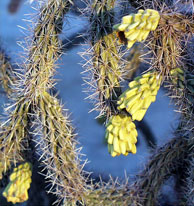 |
||||||||||||||||
|
Cane
Cholla Fruit
|
|||||||||||||||||
| People in all parts of the world grow and sell cactus plants. Sometimes people dig cactus plants out of natural areas to sell. This is illegal in Arizona and New Mexico. Certain species of cactus such as the saguaro and organ pipe are in danger of becoming extinct. National parks and preserves protect them. | |||||||||||||||||
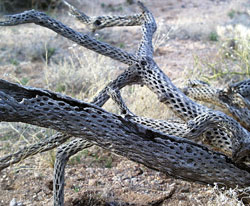 |
Mistaken for Cacti: Newcomers to the Southwest US are sometimes confused by plants that they think are cactus. 'Not-cactus' plants include Century plants, hen-and-chicks, yuccas, sotol, bear grass, desert pineapple and ocotillo. Examine the photo of the 'Desert Garden' at the top of this page. Can you identify any non-cactus plants? |
||||||||||||||||
| Cholla Wood | |||||||||||||||||
|
More Information | Main Page | Basics | More Detail | In Depth | WebQuest | | Living Things | NatureScapes | Note:
All photographs taken with a digital camera in Arizona, New Mexico,
Utah, and Texas. |
|||||||||||||||||
